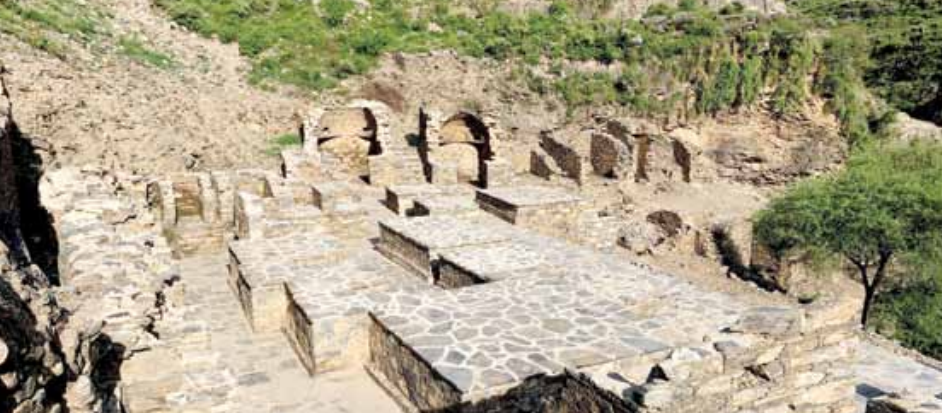
PUBLISHED
July 13, 2025
MARDAN:
High in the hills in Sawaldher village of Mardan district, Khyber Pakhtunkhwa (KP) lie the time-tested remains of the somewhat 2000-year-old and once-thriving, Thareli Buddhist archeological site, from the ancient Gandhara civilisation. It once served as an educational institution and spiritual complex of Buddhism for about 550 years during Kushan dynasty. While rich in history and cultural significance, Thareli today remains on the fringes of public awareness and government attention. With narrow access roads, minimal facilities, and limited promotion, the site’s potential as a religious tourism destination remains untapped, despite its standing as the third-largest Buddhist site in Mardan district.
Located about nineteen kilometres from Mardan city on a hilltop approximately 300 metres high, the site has preserved stupas, and chapels where sculptures of Buddha were placed for worship, as well as a residential area at high altitude in mountain.
“After Takht Bhai and Jamal Gahri Buddhist remains, Thareli is the third-largest historical site in Mardan district,” shares Dr Ghayur Shahab, a faculty member of the department of archeology at the University of Malakand and the then in-charge of Mardan Museum. “It was constructed during the Kushan period, from 1st century BC to 5th century AD. After its construction, the site remained active for 550 years. The decline of Buddhism began when the state stopped supporting it. With the arrival of the Huns and later the Muslims, Buddhism came to an end in this region.”
According to the directorate of archeology and museums, KP, the complex was first discovered in 18th century and then from 1964 to 1967, a Japanese archaeological mission began excavations of the site and uncovered the main stupa beside a spring, surrounded by several votive stupas, students’ quarters, monks’ cells, assembly halls and chapels.

Constructed with diaper masonry, the main stupa featured niches that housed Buddhist sculptures. The site spanned over multiple terraced spurs with evidence of multistoried structures.
“This site was a religious seminary where Buddhism was taught, studied and practiced,” shares Dr Shahab. “Antiquities excavated from the site include Buddhist panels revealing the life stories of Buddha, sculptures, stucco sculptures and coins. These are 1752386819 showcased in the Peshawar and Lahore Museums.”
Junaid Khan, a local resident of the area, said that like other historical sites in KP, Thareli Buddhist complex is suitable and relevant for religious tourism.
“However, unfortunately only tourists from nearby villages visit the site,” he adds. “The Pakistan Tehreek Insaf (PTI) provincial government has so far failed to fulfill its promises regarding the promotion of religious tourism in the religion. A major obstacle in the promotion of the thousand-years-old historical complex is the road leading to the archeological site, which is narrow and dilapidated. In addition to the construction of a proper road and walking tracks, it is crucial that the government must focus on promoting the site through main stream and social media.”
According to Khan, initially, the site was under the jurisdiction of the federal government. In 2010, it was handed over to the provincial directorate of archaeology, and in 2013, the KP government protected it under the Antiquities Act and carried out some conservation and restoration work.
“In 2023, the Peshawar High Court, in a verdict, banned crush plants, mining, and blasting within one kilometre of the site,” officials in the directorate revealed.
“For the promotion of religious tourism, we need to attract foreigners from Buddhist countries to visit these sites,” shares Bakhat Muhammad, deputy director of directorate of archeology and museums, KP.
He added the Thareli archeological complex is important for religious tourism but because of security concerns, the local police do not allow foreigners to visit this monastic complex and the Jamal Garhi site. As a result, they only visit the Takht Bhai monastic complex which has a negative impact on tourism.
“The site spreads over 253 kanals in a mountainous area,” shares the deputy director. “Currently, no entry fee is collected and the site is not officially open to visitors.”
Regarding further excavation and development, Bakhat Muhammad said that a two-year project for eight historical sites, including Thareli complex has been approved, adding that under the project, excavation, conservation and development will be carried out before the site is opened for local and foreigner visitors with proper facilities.
Thareli’s crumbling chapels, centuries-old stupas, and scattered sculptures represent more than just historical artefacts — they are fragments of a pluralistic and intellectual past that once defined the region. Yet despite its profound archaeological and spiritual significance, the site lies in neglect, eclipsed by more accessible or popular monuments like Takht Bhai. With renewed efforts in excavation, conservation, and infrastructure, Thareli could emerge not only as a key node in the Gandharan heritage trail but also as a source of cultural diplomacy and economic opportunity through religious tourism. For that to happen, however, preservation must meet promotion — and history must be given a second life.
Razzaq is a Peshawar-based radio and print journalist. He tweets @TheAbdurRazzaq
All facts and information are the sole responsibility of the writer






